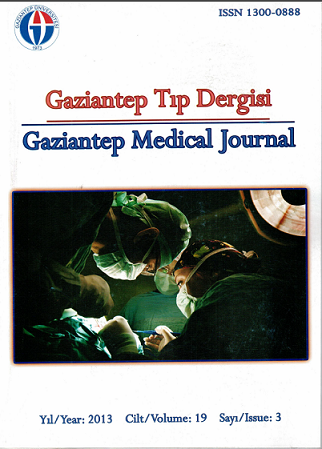Anesthesia for tracheostomy in an infant with Apert syndrome*
DOI:
https://doi.org/10.5455/GMJ-30-2013-141Keywords:
Apert syndrome, infant, general anesthesiaAbstract
Apert syndrome is a rare, autosomal dominantly inherited disease characterized by irregular craniosynostosis and some malformations involving face, hands and feet. Respiratory functions are frequently deteriorated due to hypoplasia of oropharyngeal and nasopharyngeal cavities. Obstructive sleep apne syndrome, cor pulmonale and sudden death syndrome are among the complications of Apert syndrome. All of these anatomical and physiopathological disorders in the airways lead to a significant concern during anesthesia practice. Difficulty in mask ventilation, difficult intubation and postoperative airway obstruction may be seen in these patients. In this case report we present our anesthetic experience in an infant with Apert syndrome whom anesthesia was given for tracheostomy and difficult intubation was encountered.
Metrics
References
Butler MG, Hayes BG, Hathaway MM, Begleiter ML. Specific genetic diseases at risk for sedation/anesthesia complications. Anesth Analg 2000;91(4):837-55.
Tolarova MM, Harris JA, Ordway DE, Vargervik K. Birth prevalence, mutation rate, sex ratio, parents' age, and ethnicity in Apert syndrome. Am J Med Genet 1997;72(4):394-8.
Cohen MM, Kreiborg S. Visceral anomalies in the Apert syndrome. Am J Med Genet 1993;45(6):758-60.
Barnett S, Claire M, Robert B. Perioperative complications in children with Apert syndrome: A review of 509 anaesthetics. Paediatr Anaesth 2011;21(1):72-7.
Soliman D, Cladis FP, Davis PJ. The pediatric patient. In: Fleisher LA, (ed). Anesthesia and uncommon diseases. 6th ed. Elsevier Saunders, Philadelphia, PA, USA, 2012; 586-626.
Lo LJ, Chen YR. Airway obstruction in severe syndromic craniosynostosis. Ann Plast Surg 1999;43(3):258-64.
Başar H, Büyükkoçak Ü, Kaymak Ç, Akpınar S, Sert O, Vargel I. An intraoperative unexpected respiratory problem in a patient with Apert syndrome. Minerva Anestesiol 2007;73(11):603-6.
Elwood T, Sarathy PV, Geiduschek JM, Ulma GA, Karl HW. Respiratory complications during anaesthesia in Apert syndrome. Paediatr Anaesth 2001;11(6):701-3.
Atalay A, Doğan N, Yüksek Ş, Erdem AF. Anesthesia and airway management in two cases of Apert syndrome: case reports. Eurasian Med J 2008;40(2):91-3.
Hemmer KM, McAlister WH, Marsh JL. Cervical spine anomalies in the craniosynostosis syndromes. Cleft Palate Journal 1987;24(4):328-33.
Metodiev Y, Gavrilova N, Katzarov A. Anesthetic management of a child with Apert syndrome. Saudi J Anaesth 2011;5(1):87–9.
Downloads
Published
How to Cite
Issue
Section
License
Copyright (c) 2023 European Journal of Therapeutics

This work is licensed under a Creative Commons Attribution-NonCommercial 4.0 International License.
The content of this journal is licensed under a Creative Commons Attribution-NonCommercial 4.0 International License.


















